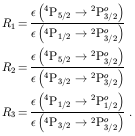


4.4. Testcase #4
We now illustrate how to use PopRatio to calculate collisionally excited emission line intensity ratios.
As an example we take the UV intercombination multiplet
2s2p2 4P -> 2s22p
2Po of C II at 2325 Å.
Intensities ratios of lines belonging to this multiplet may serve as a
useful indicator of
electronic densities in the range
107  ne
ne
 1010 cm-3
[23,
24].
These lines have been observed in the spectra of a variety of
astronomical objects: planetary nebulae
[25], giant stars
[26,
27],
symbiotic stars
[28]
and in the solar chromosphere and transition region
[29].
1010 cm-3
[23,
24].
These lines have been observed in the spectra of a variety of
astronomical objects: planetary nebulae
[25], giant stars
[26,
27],
symbiotic stars
[28]
and in the solar chromosphere and transition region
[29].
The emissivity of a line is given by [4]:
We calculate the following emissivity ratios as a function of electronic
density:
We take into account collisions by electrons and protons and
fluorescence induced by a black
body radiation field of temperature T* = 4000K
attenuated by a geometric dilution factor
f = 0.5 (which might be representative of a stellar chromosphere).
In the high density limit function LTEDEV is called to show that the
level populations differ from LTE conditions by less than 0.4%.
To run this testcase the user must include the black body radiation
field in the body of function URAD in module POPRATIO:
urad = Planck(4.0E3_WP,c/lambda*1.0E8_WP)

